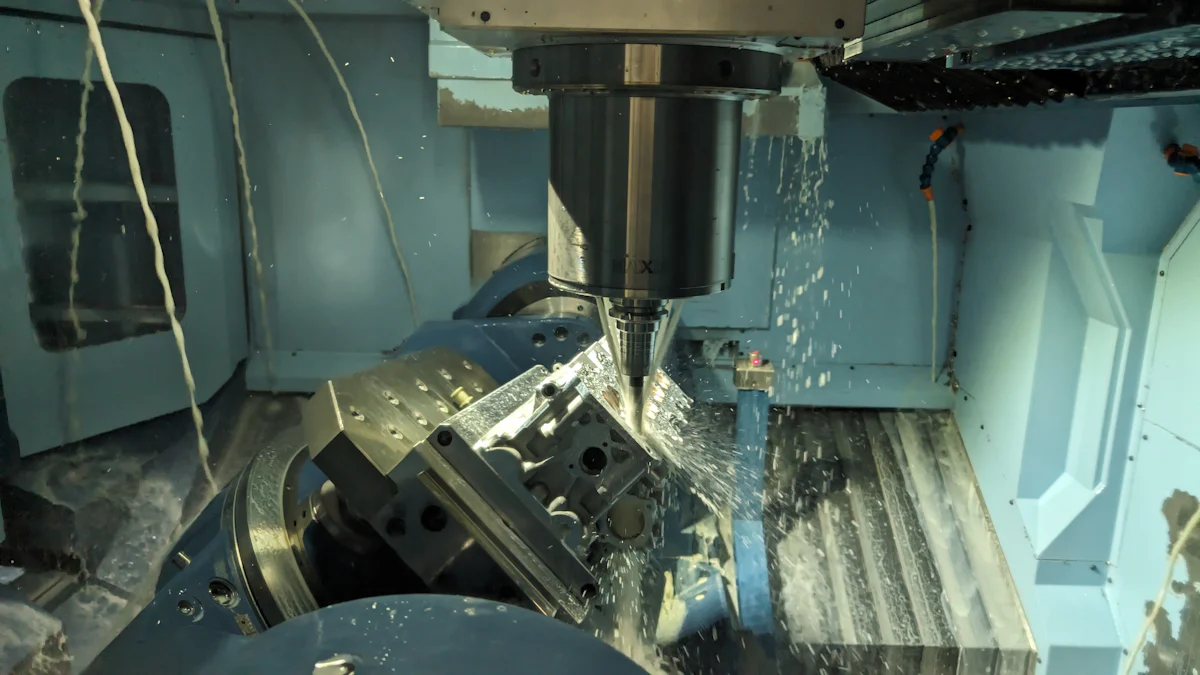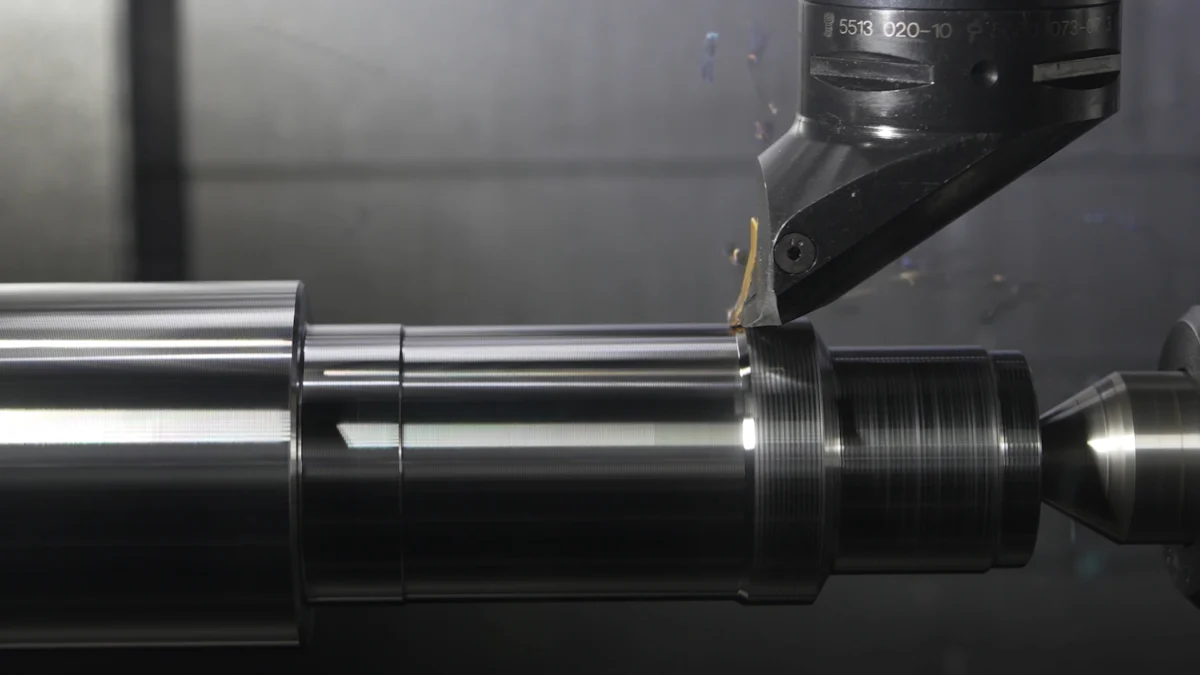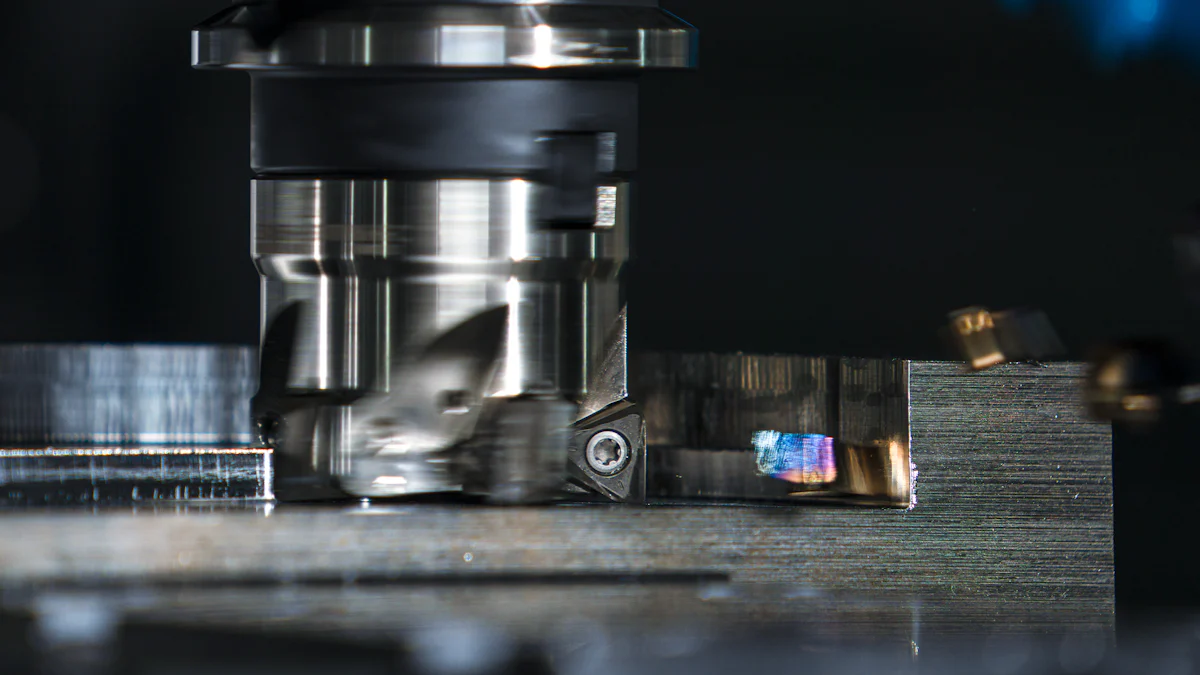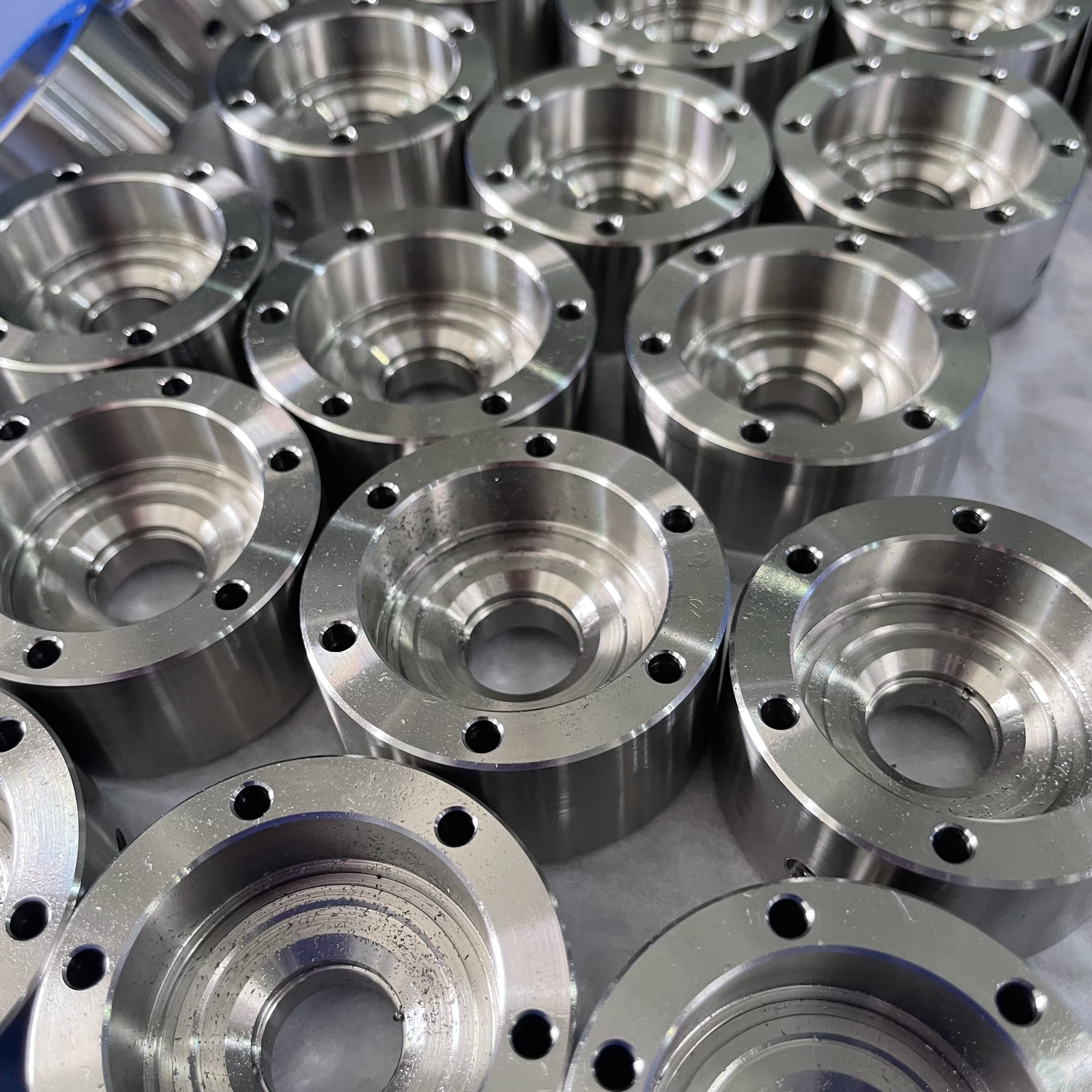The Role of CNC in Working with High-Strength Alloys

CNC machining plays a vital role in shaping high-strength alloys like titanium and aluminum. These materials are essential in industries such as aerospace and automotive due to their exceptional strength-to-weight ratios. However, machining these alloys presents unique challenges. For example:
Superalloys harden quickly during cutting, which increases tool wear.
Their heat retention creates high temperatures that can damage tools and workpieces.
Abrasive elements in these alloys cause rapid wear on cutting edges.
CNC machining overcomes these obstacles by using advanced tools and precise programming. In 2023, CNC machining centers accounted for 61.6% of global market revenue, showcasing their importance in manufacturing. You can rely on this technology to achieve precision and efficiency, even with the toughest materials.
Key Takeaways
CNC machines are important for shaping strong metals like titanium and aluminum. These metals are used in industries like airplanes and cars.
Special tools and methods, like super-cold cutting and cooling sprays, help control heat and make tools last longer.
Using automation in CNC machines makes work faster and reduces mistakes. It also keeps the quality the same for large amounts of products.
CNC machines can watch for problems in real time. This helps fix issues quickly and stops big mistakes or wasted materials.
Learning about new ideas, like using AI and eco-friendly methods, can make CNC work better and improve how things are made.
Challenges in Machining High-Strength Alloys
Material Hardness and Its Impact on Tool Wear
High-strength alloys are known for their exceptional hardness, which makes them ideal for demanding applications. However, this same property poses significant challenges during machining. Harder materials exert greater forces on cutting tools, leading to faster wear and tear. You may find that tools require frequent replacements, which increases downtime and production costs.
Harder materials tend to cause more tool wear during CNC machining. The cutting tools experience higher forces and stresses when machining hard materials, leading to faster tool deterioration. This necessitates more frequent tool changes, increasing production costs and downtime.
To address these challenges, CNC machining employs advanced cutting tools made from materials like carbide or ceramic. These tools are specifically designed to withstand the stresses of machining hard alloys. Additionally, optimizing cutting speeds and feed rates can help reduce tool wear and improve efficiency.
Heat Resistance and Thermal Management Issues
High-strength alloys often retain heat during machining, which can damage both the tool and the workpiece. Effective thermal management is crucial to prevent overheating and ensure a smooth machining process. Techniques like cryogenic machining, precision spray cooling, and coolant-impregnated tooling are commonly used to manage heat.
Cryogenic Machining: Liquid nitrogen absorbs heat, extending tool life during high-speed operations.
Precision Spray Cooling: A controlled spray of coolant targets the cutting zone for efficient cooling.
Coolant Impregnated Tooling: Tools release coolant directly into the cutting area to minimize thermal buildup.
By using these methods, you can maintain the integrity of the workpiece and prolong the lifespan of your tools.
Precision Requirements for Complex Geometries
Machining high-strength alloys often involves creating intricate designs with tight tolerances. Achieving this level of precision requires advanced CNC machining capabilities. For example, 4- and 5-axis milling machines allow you to produce complex geometries with greater accuracy compared to traditional 3-axis systems.
To ensure precision, you must optimize the tool path and balance the feed rate with the cutting speed. Minimizing tool deflection and vibration is also critical for achieving the desired accuracy. CNC machining excels in meeting these requirements, enabling you to produce high-quality components for industries like aerospace and automotive.
High Costs of Errors and Material Waste
Working with high-strength alloys comes with high stakes. These materials are expensive, and any machining error can result in significant financial losses. You must consider the cost of the raw material, the time spent on machining, and the potential downtime caused by mistakes. Errors not only waste material but also disrupt production schedules.
Did you know? Titanium, a commonly used high-strength alloy, costs up to $35 per kilogram. A single mistake can waste hundreds of dollars in material alone.
CNC machining minimizes these risks by offering unparalleled precision and repeatability. Advanced programming ensures that each cut follows the exact specifications, reducing the likelihood of errors. You can also rely on simulation software to test machining processes before cutting begins. This allows you to identify potential issues and make adjustments without wasting material.
Another way CNC machining reduces waste is through optimized tool paths. By calculating the most efficient cutting route, CNC systems minimize unnecessary material removal. This not only saves material but also reduces wear on cutting tools, further lowering costs.
Key Benefits of CNC in Reducing Waste:
Accurate cuts prevent material loss.
Simulation tools identify errors early.
Efficient tool paths save time and resources.
Additionally, CNC machines often include real-time monitoring systems. These systems detect anomalies during machining and make adjustments to prevent errors. For example, if a tool begins to wear out, the machine can compensate by altering the feed rate or cutting speed.
By leveraging CNC technology, you can significantly reduce material waste and avoid costly errors. This ensures that your operations remain efficient and cost-effective, even when working with the most challenging alloys.
Capabilities of CNC Machining for High-Strength Alloys

Advanced Cutting Tools for Tough Materials
When machining tough materials like titanium, you need cutting tools that can handle extreme conditions. Advanced tools, such as Kennametal’s HARVI indexable insert endmill, are specifically designed for this purpose. These tools feature variable rake angles that enable chatter-free machining, even at high speeds. The HARVI cutter’s inserts come with a TiAlN coating, which withstands the high temperatures generated during titanium machining.
For optimal results, you should use positive rake indexable cutters with sharp inserts and gentle edge preparation. End mills with variable helix angles reduce chatter, ensuring smoother operations. Coatings like AlTiN, TiCN, or TiAlN on submicron-grade carbide tools enhance durability and performance. These innovations allow you to machine high-strength alloys efficiently while minimizing tool wear.
Precision Programming for Intricate Designs
CNC machining excels in creating intricate designs with tight tolerances. Precision programming ensures that every cut follows exact specifications, enabling you to produce complex geometries with ease. Advanced software allows you to simulate machining processes before starting, helping you identify potential issues and optimize tool paths.
By using multi-axis CNC machines, such as 4- or 5-axis systems, you can achieve greater flexibility and accuracy. These machines allow you to approach the workpiece from multiple angles, reducing the need for repositioning. This capability is essential for industries like aerospace, where components often feature intricate designs and require flawless precision.
Real-Time Monitoring and Adaptive Adjustments
Real-time monitoring systems in CNC machining provide you with valuable insights during the machining process. These systems detect anomalies, such as tool wear or excessive vibration, and make adaptive adjustments to maintain accuracy. For example, if a tool begins to wear out, the machine can automatically adjust the feed rate or cutting speed to compensate.
Automation further enhances consistency and scalability. Robotic arms handle tasks like tool changes, while bar feeders supply materials continuously, reducing idle time. These features ensure that your operations remain efficient, even during high-volume production runs. By leveraging these capabilities, you can achieve consistent results and lower scrap rates, saving both time and resources.
Automation for Consistency and Scalability
Automation in CNC machining plays a crucial role in maintaining consistency and scaling production. By integrating automated systems, you can achieve uniform results across all components, even in high-volume manufacturing. This ensures that every part meets the same quality standards, reducing variability and errors.
One of the key benefits of automation is its ability to streamline repetitive tasks. For example, robotic arms can handle tool changes, material loading, and unloading. This eliminates manual intervention, saving time and reducing the risk of human error. Automated bar feeders supply raw materials continuously, allowing the machine to operate without interruptions.
Tip: Use robotic arms and bar feeders to maximize efficiency during long production runs.
Automation also enhances scalability. When demand increases, you can rely on CNC machines to maintain the same level of precision and quality. Automated systems ensure that production scales up without compromising accuracy. This makes CNC machining ideal for industries like aerospace and automotive, where large quantities of high-strength alloy components are required.
Real-time monitoring systems further improve consistency. These systems track variables like tool wear, vibration, and temperature. If an issue arises, the machine adjusts parameters automatically to maintain optimal performance. For instance, if a tool begins to wear, the system can reduce the feed rate to prevent defects.
Advantages of Automation in CNC Machining:
Uniform quality across all parts.
Faster production with minimal downtime.
Reduced reliance on manual labor.
Improved scalability for large orders.
By leveraging automation, you can boost productivity while ensuring consistent results. This not only saves time but also reduces costs, making your operations more efficient and competitive.
Benefits of CNC Machining in Industrial Applications
Enhanced Efficiency and Reduced Downtime
CNC machining significantly improves efficiency by automating processes and reducing human error. Machines operate autonomously, allowing you to focus on strategic tasks rather than manual operations. This automation minimizes mistakes, ensuring smoother workflows and shorter lead times.
You can also rely on CNC machines to produce parts faster than traditional methods. Their precision eliminates the need for rework, saving time and resources. Additionally, real-time monitoring systems detect issues like tool wear, enabling immediate adjustments to maintain performance. These features reduce downtime and keep production running seamlessly.
Key Efficiency Benefits:
Faster production speeds.
Reduced human error.
Continuous operation with minimal intervention.
By leveraging these capabilities, you can enhance productivity and meet tight deadlines without compromising quality.
Superior Product Quality and Tight Tolerances
CNC machining delivers exceptional product quality by achieving tight tolerances and consistent results. Machines can cut with accuracy down to fractions of a millimeter, ensuring components meet exact specifications. This level of precision is essential for industries like aerospace, where even minor deviations can lead to failure.
Automation plays a critical role in maintaining uniformity. Every part produced matches the design, eliminating variability common in manual methods. CNC systems also excel at machining advanced materials, enabling you to create high-performance products that meet rigorous standards.
How CNC Ensures Quality:
Precision programming for tight tolerances.
Consistency across high-volume production.
Real-time quality control for error detection.
With CNC machining, you can achieve superior quality while maintaining efficiency, even for complex designs.
Cost Savings Through Material Optimization
CNC machining helps you save costs by optimizing material usage. Simplifying part designs reduces machining steps, cutting production time and expenses. Standardized components eliminate the need for custom tooling, further lowering costs.
Efficient tool paths minimize unnecessary movements, reducing machining time and material waste. Choosing the right material also plays a vital role. For example, selecting machinable materials like aluminum can decrease tool wear and production costs.
Cost-Saving Strategies:
Simplified designs to reduce machining steps.
Standardized features to avoid custom tooling.
Optimized processes to minimize waste.
By implementing these strategies, you can maximize efficiency and reduce expenses without sacrificing quality.
Scalability for High-Volume Manufacturing
CNC machining offers unmatched scalability, making it ideal for high-volume manufacturing. When demand increases, you can rely on CNC systems to maintain precision and efficiency without compromising quality. This capability is essential for industries like aerospace, automotive, and medical devices, where large quantities of components must meet strict standards.
One of the key advantages of CNC machining is its ability to replicate designs with absolute consistency. Once you program the machine, it produces identical parts repeatedly, ensuring uniformity across the entire production run. This eliminates variability, which is common in manual methods, and guarantees that every component meets the required specifications.
Tip: Use CNC machines with multi-axis capabilities to handle complex designs in high-volume production.
Automation plays a critical role in scaling up production. Robotic arms, automated material feeders, and tool changers streamline operations, reducing downtime and increasing throughput. For example, bar feeders supply raw materials continuously, allowing the machine to operate for extended periods without manual intervention. This ensures that your production line runs smoothly, even during long shifts.
CNC systems also support batch production. You can program the machine to produce different parts in sequence, reducing setup times between batches. This flexibility allows you to meet diverse customer demands while maintaining efficiency.
Benefits of CNC Scalability:
Consistent quality across all parts.
Faster production cycles with minimal downtime.
Flexibility to handle varying production volumes.
By leveraging CNC technology, you can scale your operations to meet high-volume demands while maintaining precision and quality. This makes CNC machining a valuable asset for any manufacturer aiming to grow their production capacity.
Innovations in CNC Machining for High-Strength Alloys

AI and Machine Learning Integration
Artificial intelligence (AI) and machine learning are transforming CNC machining. These technologies analyze real-time data to optimize machining processes and improve precision. AI systems can predict maintenance needs, reducing downtime and extending machine life. You can rely on AI to enhance quality control by identifying defects early and making adjustments during production.
Machine learning allows CNC machines to learn from past operations. Over time, they improve their performance by adapting to new inputs and optimizing tool paths. This capability boosts productivity and ensures consistent results. AI also automates repetitive tasks, reducing human error and increasing efficiency.
Key Benefits of AI in CNC Machining:
Predictive maintenance minimizes downtime.
Real-time data analysis improves precision.
Automation enhances consistency and reduces errors.
By integrating AI, you can meet the growing demand for high-quality products while managing costs effectively.
Advanced Cutting Tool Materials
Machining high-strength alloys requires cutting tools that can withstand extreme conditions. Superalloys, for example, work-harden rapidly and retain heat, which can damage tools. Abrasive elements like chromium and tungsten accelerate tool wear, while built-up edges affect surface finish and accuracy. You need advanced materials to overcome these challenges.
Cubic boron nitride (CBN) and polycrystalline diamond (PCD) are ideal for machining tough alloys. These materials resist wear and handle high temperatures effectively. Coated tools, such as those with titanium aluminum nitride (TiAlN), further enhance durability. Using these tools ensures smoother operations and longer tool life.
Tip: Choose tools with coatings like TiAlN or materials like CBN for better performance when machining superalloys.
With the right cutting tools, you can achieve precision and efficiency, even with the most challenging materials.
Hybrid CNC Machines for Additive and Subtractive Processes
Hybrid CNC machines combine additive and subtractive manufacturing, offering unique advantages. These machines add material only where needed, reducing waste and material costs. You can repair damaged parts or create complex geometries without traditional casting or assembly processes. Switching between additive and subtractive modes saves time by eliminating the need to move the workpiece.
Hybrid machines also allow you to combine different metals, tailoring mechanical properties to specific applications. This flexibility is especially valuable in industries like aerospace and medical, where prototyping and repairs are critical.
Advantages of Hybrid CNC Machines:
Reduced material waste and finishing work.
Precise internal features during part creation.
Time savings with seamless process transitions.
By adopting hybrid CNC technology, you can streamline production and expand your manufacturing capabilities.
Emerging Trends in CNC Technology
CNC technology continues to evolve, offering you new ways to improve efficiency and precision. Staying updated on these trends helps you stay competitive in the manufacturing industry. Here are some of the most exciting advancements shaping the future of CNC machining:
Digital Twin Technology:
Digital twins create virtual replicas of CNC machines and processes. You can use these models to simulate machining operations before starting production. This reduces errors and helps you optimize tool paths. By testing virtually, you save time and minimize material waste.5G Connectivity:
Faster and more reliable communication between CNC machines and control systems is now possible with 5G. This technology allows you to monitor and control machines remotely in real time. It also improves data transfer speeds, enabling quicker adjustments during production.Eco-Friendly Machining:
Sustainability is becoming a priority in manufacturing. CNC systems now include features like energy-efficient motors and coolant recycling. These innovations help you reduce your environmental impact while lowering operational costs.
Note: Adopting eco-friendly practices not only benefits the planet but also enhances your brand's reputation.
Collaborative Robots (Cobots):
Cobots work alongside human operators to handle repetitive tasks. They are easy to program and integrate into your existing CNC setup. By using cobots, you can increase productivity and reduce the risk of workplace injuries.Augmented Reality (AR) for Training:
AR tools provide interactive training for CNC operators. You can visualize machine operations and learn complex processes more effectively. This technology shortens the learning curve and improves workforce skills.
Tip: Explore AR-based training programs to upskill your team and boost overall efficiency.
These trends demonstrate how CNC technology is advancing to meet modern manufacturing demands. By embracing these innovations, you can enhance your capabilities and stay ahead in a competitive market.
CNC machining has become essential for handling high-strength alloys, addressing challenges like material hardness, heat retention, and precision demands. Its advanced capabilities, such as multi-axis machining and CAD/CAM integration, ensure efficiency and accuracy in producing complex geometries. These innovations are particularly valuable in industries like aerospace, where precision and material performance are critical.
The evolution of CNC technology continues to drive manufacturing innovation. High-performance coatings for cutting tools and the development of new aluminum alloys expand the range of applications in aerospace and automotive sectors. Additionally, integrating CNC machining with IoT and smart factories optimizes production processes, making them more flexible and responsive. As these advancements progress, you can expect CNC machining to enable the creation of even more advanced materials and designs.
Takeaway: CNC machining not only enhances efficiency and quality but also ensures cost-effectiveness, making it indispensable for modern manufacturing.
FAQ
What makes CNC machining suitable for high-strength alloys?
CNC machining offers precision, repeatability, and advanced tool options. These features allow you to handle the hardness and heat resistance of high-strength alloys effectively. CNC systems also optimize cutting paths and speeds, reducing tool wear and ensuring consistent results.
How does CNC machining reduce material waste?
CNC machines use precise programming to minimize unnecessary cuts. Simulation software helps you test processes before machining, avoiding errors. Efficient tool paths and real-time monitoring further reduce waste by ensuring accurate cuts and detecting issues early.
Can CNC machines handle complex designs?
Yes, CNC machines excel at creating intricate geometries. Multi-axis systems, like 4- and 5-axis machines, allow you to approach workpieces from multiple angles. This capability ensures tight tolerances and eliminates the need for repositioning, making it ideal for complex designs.
What industries benefit most from CNC machining?
Industries like aerospace, automotive, and medical devices rely heavily on CNC machining. These sectors demand high precision, tight tolerances, and the ability to work with advanced materials. CNC technology ensures consistent quality and scalability for these critical applications.
How does automation improve CNC machining?
Automation streamlines repetitive tasks like tool changes and material loading. It reduces human error and increases production speed. Real-time monitoring systems also adjust parameters automatically, ensuring consistent performance. This makes automation essential for high-volume manufacturing.
Tip: Use robotic arms and bar feeders to maximize efficiency in automated CNC setups.
See Also
CNC Machining Aluminum Alloys 6061 And 7075: A 2024 Overview
The Impact of CNC Machining on Precision Manufacturing Techniques
CNC Machining Process and Uses of Aluminum Alloy 7075
Benefits of Utilizing Aluminum CNC Machining Services Explained
About US
Follow Us
Your prototype holds unparalleled significance, and we deeply value its uniqueness. Collaborating with you during the preparation phase for running your prototype or parts is a commitment we gladly embrace. Whether it's a single part or a complex assembly, we are dedicated to selecting the optimal tools and pathways to bring your envisioned product to life.
At Precision Fab CNC Machining, we specialize in producing parts for prototypes, short runs, and high-volume production. Our prototyping machine capabilities extend across metal, plastic, and wood machining, with welding fabrication services available to complement and finalize your prototype if required.
Address
Address: Room320 10F, Building A,Nanshan international building, Dayawan District, Huizhou, Guangdong, 516001 China
Contacts
billy@timaycnc.com

